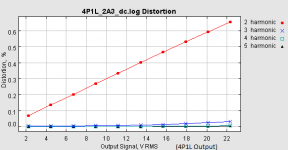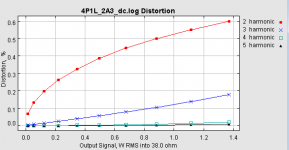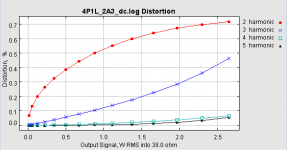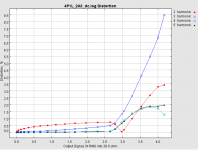Serving suggestion for 4P1L - 2A3 dc coupled.
to keep Anatoliy happy, the 2A3 anode current servos the operating current of the shunt cascode, to give dc-stabilised operating point.
2A3 needs -100V bias supply (10mA), but this does give a startup voltage of -100V, to be kind to the 2A3.
Darlington connected PNP shown. NXP Semiconductors PBHV9040Z assumed for main PNP. others are -T package (SOT23) - so yes, PCB needed for correct layout.
To keep the 400mV (pk) sensitivity, the gain of the shunt cascode is increased to 62, to allow for the low mu of the 2A3. It's the beauty of shunt cascode - you can set the gain independent of the stage's triode current.
Thanks Rod, just now had a bit of time to quickly simulate this. For those interested in the harmonic profile here is a view of the output and the 2A3 grid (or the 4P1L output).
interesting to see that the shunt cascode performs superbly and provides H2 mainly from the 4P1L whereas the output stage obviously increases H3 as expected
Attachments
Thanks Rod, just now had a bit of time to quickly simulate this. For those interested in the harmonic profile here is a view of the output and the 2A3 grid (or the 4P1L output).
interesting to see that the shunt cascode performs superbly and provides H2 mainly from the 4P1L whereas the output stage obviously increases H3 as expected
thanks for the plot, what is the max, can it take the 2A3 up to a higher output around 3-4W whch should handle the HE-6 and AKG 1k, then all the "top" 50 dynamic headphones would be covered.
Here you go. Interesting to see the H2 cancellation close to 3W but with an increased presence of H3
Ale
For 1W output this is remarkbly similar to what I got for real with the best 2A3's. Typically is a bit worse.
Here you go. Interesting to see the H2 cancellation close to 3W but with an increased presence of H3
Ale
Maybe you'll get better results at low levels if you use a 4P1L as output device or use the 2A3 with higher primary impedance.
So 45 was correct. I was way overestimating my power requirements based on just short listening.
Thanks Regal!
You don't need a 2A3 anymore then...
Wouldn't 1 W provide massive headroom for 99.99% of users? 4p1l output seems the obvious choice?
enzo
Ok lets do some quick math.
The 4P1l operating point as an output tube has a max 16V grid bias, with a mu of 8.
So the most the plate can swing without going over 0 V grid bias is:
16x8= 128 Vp-p
Now take a 5k:38 transformer thats a 11.5:1 ratio, so 128/11.5 = 11 Vp-p at the secondary.
Now we have about 10 ohms DCR on a 5k:38 ohm secondary.
So (38-10)/38*11= 8 Vp-p voltage applied to a 38 ohm voice coil
Take 3% loss for transformer and convert to RMS 8*.97/(2*1.44) = 2.8Vrms
P=2.8^2/38= 0.2W amplifer real world.
Now is this enough power for 99% of all headphones, well yes but we could do just as well with a spud 6c45p1 or any of pmillet's famous triode connected pentodes.
That's my argument/hypothesis. I say we want to avoid A1/A2 with headphones, so with DHT's and headphones go big or go home
To be honest, if we don't have enough interest to make the coleman cascode shunt pcb, we should just use a classic idht driver to 2A3/300B/PX4 if we need the power , or we stick to the proven SSHV super tube/spud for maximum linearity.
If anything I think this thread has shown that it is tougher to build a headphone SET and really tough to beat the shunt reg spud amps a few of us have been building. I don't think we can touch a spud amp for linearity with DHT's, but we can outpower them only with a tube that has a low Rp allowing a smaller ratio transformer. Parafeed with a nickel core allows a much lower DCR secondary which gains nearly 20% power also.
Last edited:
With the greatest respect I'm not sure i agree with all your maths re operating point. I don't think we should worrie too much about straying into A2 if we're willing to accept some sort of ss mu output, be it dc gyrator or something along the Rod Coleman idea. If 2.5W A2 is doable (real world tested) into 8r i struggle to believe we're limited to 0.2W into 38r.
I'm no expert, so I'm happy to be told i'm wrong. Will have a closer look at the curves.
enzo
I'm no expert, so I'm happy to be told i'm wrong. Will have a closer look at the curves.
enzo
If anything I think this thread has shown that it is tougher to build a headphone SET and really tough to beat the shunt reg spud amps a few of us have been building.
I think the real lesson is that it's tough to please everybody with one single amp; a crazy undertaking IMHO. There were enough suggestions that would cover almost every request.
According to my calculations and experiments, you can get up to 1.8W of clean power in A1, or 2.5W in A2. from a single 4P1L.
Interesting, could you post the schematic.
Interesting, could you post the schematic.
You can find it somewhere on one of previous pages, with the link to my original thread about "http://www.diyaudio.com/forums/tubes-valves/183329-one-more-4p1l-se.html"
This afternoon I drove the 4P1L output directly with a 1:5 step up transformer. It was enough for my SD580 cans on a 25:1 output. It seems to me that a 5:1 OPT (5K:200R) would give plenty of voltage for headphones in the 300 ohm range.
The trouble with input step-up transfo was that bass distortion was awful. Not really usable below 200Hz. Still, with a 5:1 OPT you could use a less aggressive, and maybe better sounding, input transformer to drive the 4P1L grid. 1:2 should it.
Horses for courses, I say. Trying to build a DHT headphone amp that can drive any and all headphones makes about as much sense as a DHT amp that can drive any and all speakers. You could do it, but why?
The trouble with input step-up transfo was that bass distortion was awful. Not really usable below 200Hz. Still, with a 5:1 OPT you could use a less aggressive, and maybe better sounding, input transformer to drive the 4P1L grid. 1:2 should it.
Horses for courses, I say. Trying to build a DHT headphone amp that can drive any and all headphones makes about as much sense as a DHT amp that can drive any and all speakers. You could do it, but why?
Part of this thread's purpose was to show how difficult it is to design an all purpose headphone amp. To show the pitfalls that are unique to headphones, its not as easy as building a pre-amp or even an SET for full range drivers.
This transformer Sowter Type 8650 Headphone Output transformer parafeed with a single 6C45p will power any non-ortho dynamic headphone except the AKG K1K's. Thats a lot of headphone selection. Whether you use a 6c4p,cg3m, one of the many high gm triode strapped pentodes doesn't matter they all have more linearity than a 2 stage DHT amplifier. They are all based on aWE437 spud schematic posted Lyn Olsen's website over 10 years ago, its the benchmark for the headphone SET amplifier
The Frank Cooter schematic I posted on the first page is sort of the DHT alternative, same power, same selection of headphones with the right transformer, a bit less linearity. We could build a variation of his design with the 4P1l and get a little more power but not much. Its an excellent alternative if you want DHT sound but don't care about modern headphone.
The new ortho headphones and the old K1K are the real reason to consider building a DHT output SET amp asa 2A3/300B/PX4 with a scaled up version of the Sowter 8665 would power any headphone driven by a 6n1p ccda. I was hoping to find an all DHT alternative (I don't really like 6Dj8's) and Rod came up with a really unique way to drive a 2A3, I think if it was parafeed (so one wouldn't have so much secondary loss) then it would power any headphone.
Wavebourne also posted a great schematic for A2 driven 4P1l that would handle the new orthos.
Headphones are different than speakers in that its hard to live with just one pair,its easy to end up with too many. The last thing you want is to hear a new headphone design only to find that your "masterpiece" SET won't work with them.
SET won't work with them.
This transformer Sowter Type 8650 Headphone Output transformer parafeed with a single 6C45p will power any non-ortho dynamic headphone except the AKG K1K's. Thats a lot of headphone selection. Whether you use a 6c4p,cg3m, one of the many high gm triode strapped pentodes doesn't matter they all have more linearity than a 2 stage DHT amplifier. They are all based on aWE437 spud schematic posted Lyn Olsen's website over 10 years ago, its the benchmark for the headphone SET amplifier
The Frank Cooter schematic I posted on the first page is sort of the DHT alternative, same power, same selection of headphones with the right transformer, a bit less linearity. We could build a variation of his design with the 4P1l and get a little more power but not much. Its an excellent alternative if you want DHT sound but don't care about modern headphone.
The new ortho headphones and the old K1K are the real reason to consider building a DHT output SET amp asa 2A3/300B/PX4 with a scaled up version of the Sowter 8665 would power any headphone driven by a 6n1p ccda. I was hoping to find an all DHT alternative (I don't really like 6Dj8's) and Rod came up with a really unique way to drive a 2A3, I think if it was parafeed (so one wouldn't have so much secondary loss) then it would power any headphone.
Wavebourne also posted a great schematic for A2 driven 4P1l that would handle the new orthos.
Headphones are different than speakers in that its hard to live with just one pair,its easy to end up with too many. The last thing you want is to hear a new headphone design only to find that your "masterpiece"
Last edited:
Sure, I think you've made your point - no argument from me. There is probably more variation in headphones than in speakers. But I would not be surprised or disappointed if the lovely DHT SET amp I had built for my horn loaded system did a poor job of driving the new Magnepans I just bought. Why should headphones be different?
I think that a single stage 4P1L with the right transformers could do a fine job of driving a lot of headphones.
I think that a single stage 4P1L with the right transformers could do a fine job of driving a lot of headphones.
When the SSHV came out, many of us built variations on the Gary Dahl spud headphone amp but there was really no thread of discussion.
For a spud 4P1l, just build a separate case for the power transformers/rectifier/prefiltering, a pair of SSHV2's, coleman filament bias and a Sowter 9650, Peerless TL404, or slagle autoformer parafed output. Not much to discuss but certainly a worthwhile build for very efficient headphones. I did did something similiar with the 71A but didn't find less distortion than a WE417A, just not enough gain for some headphones.
Its the new orthos that make things tough yet interesting.
headphone SET's can be broken down to three types and their pioneer:
1. high gm spud (Gary Dahl's Espressivo)
2. two stage dc coupled 71A/45/4P1L all DHT type (Frank Cooter)
3. The two stage IDHT to 2A3/300B/PX4/EL34 (Eddie Current/Moth)
4 the 633c/6as7 (Eddie Current)
With Rod's work #2 & #3 are well within reach for the DiYer and we couldn't say that a few years ago, and his shunt cascode brings #2 closer to #3.
For a spud 4P1l, just build a separate case for the power transformers/rectifier/prefiltering, a pair of SSHV2's, coleman filament bias and a Sowter 9650, Peerless TL404, or slagle autoformer parafed output. Not much to discuss but certainly a worthwhile build for very efficient headphones. I did did something similiar with the 71A but didn't find less distortion than a WE417A, just not enough gain for some headphones.
Its the new orthos that make things tough yet interesting.
headphone SET's can be broken down to three types and their pioneer:
1. high gm spud (Gary Dahl's Espressivo)
2. two stage dc coupled 71A/45/4P1L all DHT type (Frank Cooter)
3. The two stage IDHT to 2A3/300B/PX4/EL34 (Eddie Current/Moth)
4 the 633c/6as7 (Eddie Current)
With Rod's work #2 & #3 are well within reach for the DiYer and we couldn't say that a few years ago, and his shunt cascode brings #2 closer to #3.
Last edited:
- Home
- Amplifiers
- Tubes / Valves
- The all DHT SET Headphone Amp



